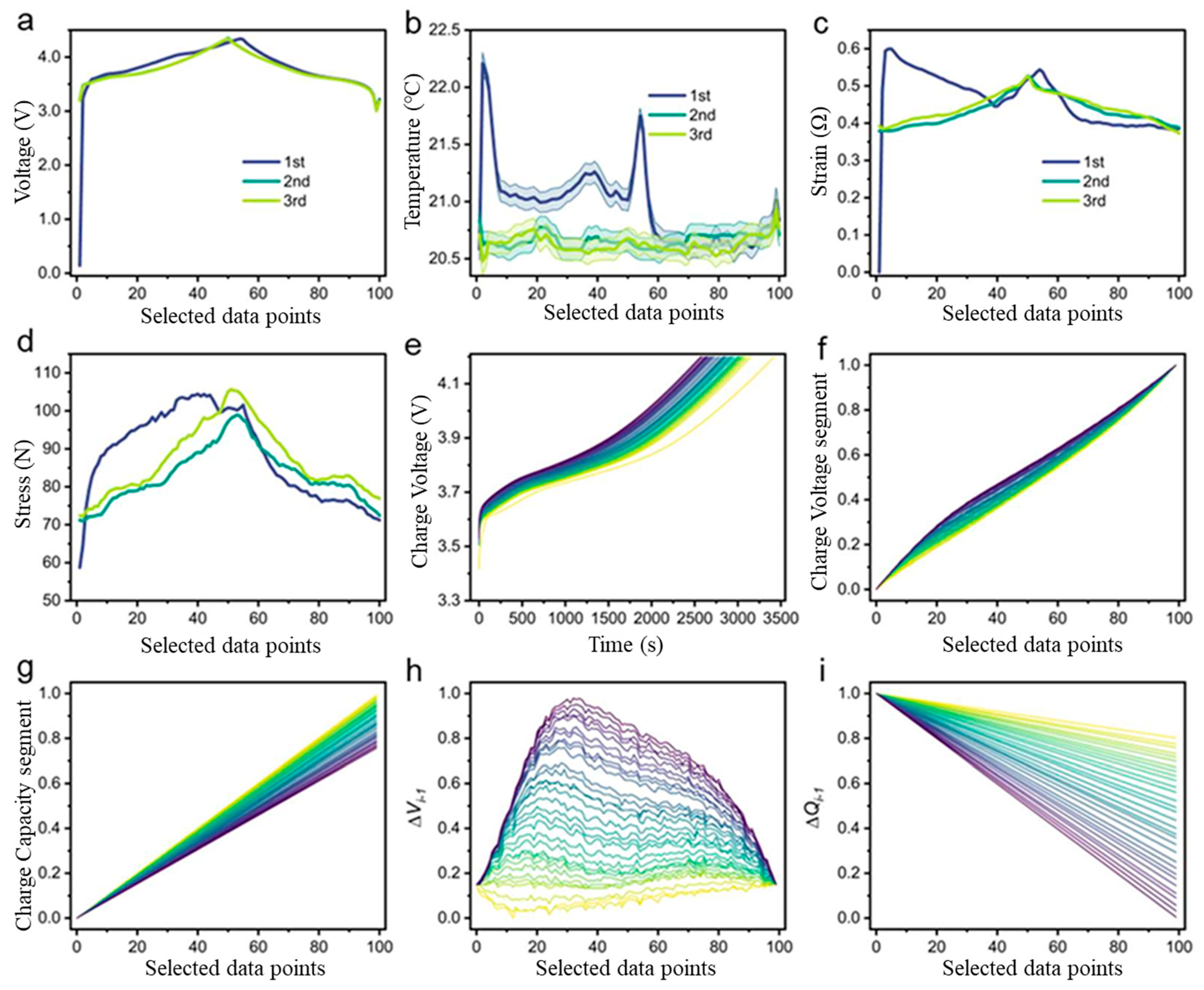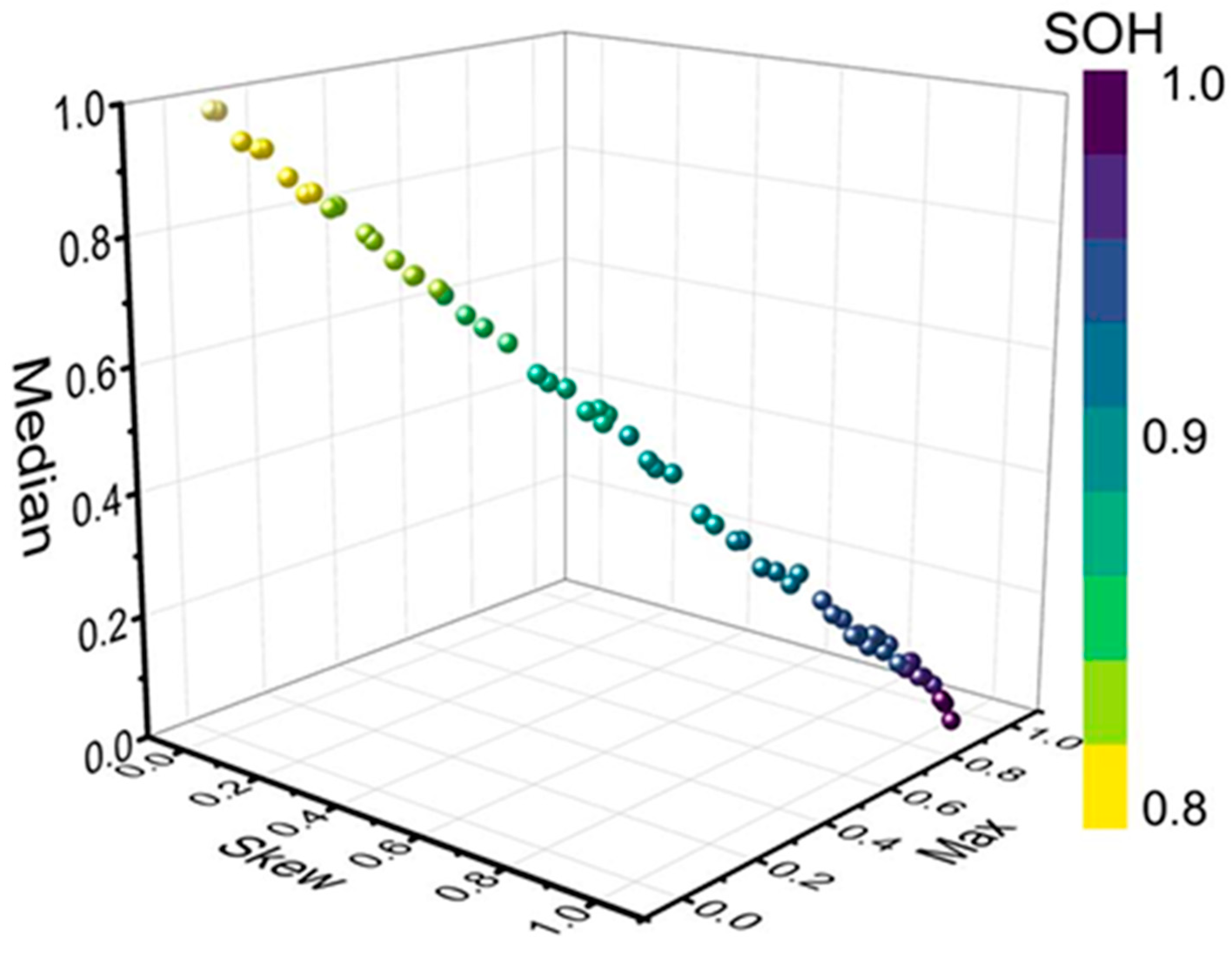Deep Mining on the Formation Cycle Features for Concurrent SOH Estimation and RUL Prognostication in Lithium-Ion Batteries
Abstract
1. Introduction
2. Experiment
2.1. Pouch Cell Preparation
2.2. Relevant Feature Extraction
2.3. Model Development
3. Results and Discussion
3.1. Collection of Datasets
3.2. Formation at Different Conditions
3.3. Feature Extraction from Formation and Cycling Process
3.4. SOH Estimation with CNN Model
3.5. SOH Estimation Based on Integrated Model
3.6. RUL Estimation
4. Conclusions
Author Contributions
Funding
Data Availability Statement
Conflicts of Interest
References
- Harper, G.; Sommerville, R.; Kendrick, E.; Driscoll, L.; Slater, P.; Stolkin, R.; Walton, A.; Christensen, P.; Heidrich, O.; Lambert, S.; et al. Recycling lithium-ion batteries from electric vehicles. Nature 2019, 575, 75–86. [Google Scholar] [CrossRef] [PubMed]
- Zhang, R.; Wang, C.; Zou, P.; Lin, R.; Ma, L.; Li, T.; Hwang, I.-H.; Xu, W.; Sun, C.; Trask, S.; et al. Long-life lithium-ion batteries realized by low-Ni, Co-free cathode chemistry. Nat. Energy 2023, 8, 695–702. [Google Scholar] [CrossRef]
- Li, Y.; Guo, W.; Stroe, D.-I.; Zhao, H.; Kristensen, P.K.; Jensen, L.R.; Pedersen, K.; Gurevich, L. Evolution of aging mechanisms and performance degradation of lithium-ion battery from moderate to severe capacity loss scenarios. Chem. Eng. J. 2024, 498, 155588. [Google Scholar] [CrossRef]
- Ng, M.-F.; Zhao, J.; Yan, Q.; Conduit, G.J.; Seh, Z.W. Predicting the state of charge and health of batteries using data-driven machine learning. Nat. Mach. Intell. 2020, 2, 161–170. [Google Scholar] [CrossRef]
- Hu, X.; Feng, F.; Liu, K.; Zhang, L.; Xie, J.; Liu, B. State estimation for advanced battery management: Key challenges and future trends. Renew. Sustain. Energy Rev. 2019, 114, 109334. [Google Scholar] [CrossRef]
- Tang, Y.; Zhong, S.; Wang, P.; Zhang, Y.; Wang, Y. Remaining useful life prediction of high-capacity lithium-ion batteries based on incremental capacity analysis and Gaussian kernel function optimization. Sci. Rep. 2024, 14, 23524. [Google Scholar] [CrossRef] [PubMed]
- Li, C.; Yang, L.; Li, Q.; Zhang, Q.; Zhou, Z.; Meng, Y.; Zhao, X.; Wang, L.; Zhang, S.; Li, Y.; et al. SOH estimation method for lithium-ion batteries based on an improved equivalent circuit model via electrochemical impedance spectroscopy. J. Energy Storage 2024, 86, 111167. [Google Scholar] [CrossRef]
- Lu, J.; Xiong, R.; Tian, J.; Wang, C.; Sun, F. Deep learning to estimate lithium-ion battery state of health without additional degradation experiments. Nat. Commun. 2023, 14, 2760. [Google Scholar] [CrossRef]
- Li, R.; Kirkaldy, N.D.; Oehler, F.F.; Marinescu, M.; Offer, G.J.; O’kane, S.E.J. The importance of degradation mode analysis in parameterising lifetime prediction models of lithium-ion battery degradation. Nat. Commun. 2025, 16, 2776. [Google Scholar] [CrossRef] [PubMed]
- Shuai, W.; Yiting, L.; Shoubin, Z.; Lifei, C.; Pecht, M. Remaining useful life prediction of lithium-ion batteries using a novel particle flow filter framework with grey model. Sci. Rep. 2025, 15, 3311. [Google Scholar] [CrossRef]
- Iftikhar, M.; Shoaib, M.; Altaf, A.; Iqbal, F.; Villar, S.G.; Lopez, L.A.D.; Ashraf, I. A deep learning approach to optimize remaining useful life prediction for Li-ion batteries. Sci. Rep. 2024, 14, 25838. [Google Scholar] [CrossRef] [PubMed]
- Wang, Y.; Zhang, X.; Li, K.; Zhao, G.; Chen, Z. Perspectives and challenges for future lithium-ion battery control and management. eTransportation 2023, 18, 100260. [Google Scholar] [CrossRef]
- Zeng, S.; Chen, S.; Alkali, B. Lithium-Ion Battery Capacity Estimation Based on Incremental Capacity Analysis and Deep Convolutional Neural Network. Energies 2024, 17, 1272. [Google Scholar] [CrossRef]
- Wan, Z.; Kang, Y.; Ou, R.; Xue, S.; Xu, D.; Luo, X. Multi-step time series forecasting on the temperature of lithium-ion batteries. J. Energy Storage 2023, 64, 107092. [Google Scholar] [CrossRef]
- Roman, D.; Saxena, S.; Robu, V.; Pecht, M.; Flynn, D. Machine learning pipeline for battery state-of-health estimation. Nat. Mach. Intell. 2021, 3, 447–456. [Google Scholar] [CrossRef]
- Tian, J.; Xiong, R.; Shen, W.; Lu, J.; Sun, F. Flexible battery state of health and state of charge estimation using partial charging data and deep learning. Energy Storage Mater. 2022, 51, 372–381. [Google Scholar] [CrossRef]
- Wang, F.; Zhai, Z.; Zhao, Z.; Di, Y.; Chen, X. Physics-informed neural network for lithium-ion battery degradation stable modeling and prognosis. Nat. Commun. 2024, 15, 4332. [Google Scholar] [CrossRef]
- Zhang, L.; Zhang, J.; Gao, T.; Lyu, L.; Wang, L.; Shi, W.; Jiang, L.; Cai, G. Improved LSTM based state of health estimation using random segments of the charging curves for lithium-ion batteries. J. Energy Storage 2023, 74, 109370. [Google Scholar] [CrossRef]
- Sun, Z.; He, W.; Wang, J.; He, X. State of Health Estimation for Lithium-Ion Batteries with Deep Learning Approach and Direct Current Internal Resistance. Energies 2024, 17, 2487. [Google Scholar] [CrossRef]
- Hosen, M.S.; Jaguemont, J.; Van Mierlo, J.; Berecibar, M. Battery lifetime prediction and performance assessment of different modeling approaches. iScience 2021, 24, 102060. [Google Scholar] [CrossRef]
- Ma, L.; Tian, J.; Zhang, T.; Guo, Q.; Hu, C. Accurate and efficient remaining useful life prediction of batteries enabled by physics-informed machine learning. J. Energy Chem. 2024, 91, 512–521. [Google Scholar] [CrossRef]
- He, W.; Li, D.; Sun, Z.; Wang, C.; Tang, S.; Chen, J.; Geng, X.; Wang, H.; Liu, Z.; Hu, L.; et al. Data-driven estimation of battery state-of-health with formation features. J. Micromechanics Microengineering 2024, 34, 075004. [Google Scholar] [CrossRef]
- Xiao, Y.; Wang, Y.; Bo, S.-H.; Kim, J.C.; Miara, L.J.; Ceder, G. Understanding interface stability in solid-state batteries. Nat. Rev. Mater. 2020, 5, 105–126. [Google Scholar] [CrossRef]
- Li, Y.; Huang, W.; Li, Y.; Pei, A.; Boyle, D.T.; Cui, Y. Correlating Structure and Function of Battery Interphases at Atomic Resolution Using Cryoelectron Microscopy. Joule 2018, 2, 2167–2177. [Google Scholar] [CrossRef]
- Shuchi, S.B.; Oyakhire, S.T.; Zhang, W.; Sayavong, P.; Ye, Y.; Chen, Y.; Yu, Z.; Cui, Y.; Bent, S.F. Deconvoluting Effects of Lithium Morphology and SEI Stability at Moderate Current Density Using Interface Engineering. Adv. Mater. Interfaces 2024, 11, 304. [Google Scholar] [CrossRef]
- Zhang, S.; Li, Y.; Bannenberg, L.J.; Liu, M.; Ganapathy, S.; Wagemaker, M. The lasting impact of formation cycling on the Li-ion kinetics between SEI and the Li-metal anode and its correlation with efficiency. Sci. Adv. 2024, 10, eadj8889. [Google Scholar] [CrossRef] [PubMed]
- Xie, S.; Ren, L.; Yang, X.; Wang, H.; Sun, Q.; Chen, X.; He, Y. Influence of cycling aging and ambient pressure on the thermal safety features of lithium-ion battery. J. Power Sources 2020, 448, 227425. [Google Scholar] [CrossRef]
- Li, Z.; Tu, H.; Wang, H.; Hu, L.; Chen, S.; Yan, R.; He, X. Data-driven assessment of lithium-ion battery degradation using thermal patterns from computer vision. J. Energy Chem. 2025, 105, 852–859. [Google Scholar] [CrossRef]








| Batch Size | |||||
|---|---|---|---|---|---|
| Learning Rate | 32 | 64 | 128 | 256 | 512 |
| 0.1 | 0.29019 | 0.290152 | 0.290378 | 0.290154 | 0.290202 |
| 0.01 | 0.290195 | 0.290379 | 0.290232 | 0.039517 | 0.29015 |
| 0.001 | 0.037637 | 0.039405 | 0.036985 | 0.036545 | 0.041746 |
| 0.0001 | 0.038932 | 0.038911 | 0.039965 | 0.041036 | 0.04941 |
| Type | Electric | Strain | Stress | Temperature | RMSE |
|---|---|---|---|---|---|
| 20−41 N | √ | 258 | |||
| 20−43 N | √ | √ | 80 | ||
| 20−47 N | √ | √ | 57 | ||
| 30−27 N | √ | √ | 150 | ||
| 30−41 N | √ | √ | √ | 36 | |
| 30−62 N | √ | √ | √ | 61 | |
| 30−64 N | √ | √ | √ | 28 | |
| 30−68 N | √ | √ | √ | 17 | |
| 30−73 N | √ | √ | √ | √ | 16 |
Disclaimer/Publisher’s Note: The statements, opinions and data contained in all publications are solely those of the individual author(s) and contributor(s) and not of MDPI and/or the editor(s). MDPI and/or the editor(s) disclaim responsibility for any injury to people or property resulting from any ideas, methods, instructions or products referred to in the content. |
© 2025 by the authors. Licensee MDPI, Basel, Switzerland. This article is an open access article distributed under the terms and conditions of the Creative Commons Attribution (CC BY) license (https://creativecommons.org/licenses/by/4.0/).
Share and Cite
Yang, D.; He, W.; He, X. Deep Mining on the Formation Cycle Features for Concurrent SOH Estimation and RUL Prognostication in Lithium-Ion Batteries. Energies 2025, 18, 2105. https://doi.org/10.3390/en18082105
Yang D, He W, He X. Deep Mining on the Formation Cycle Features for Concurrent SOH Estimation and RUL Prognostication in Lithium-Ion Batteries. Energies. 2025; 18(8):2105. https://doi.org/10.3390/en18082105
Chicago/Turabian StyleYang, Dongchen, Weilin He, and Xin He. 2025. "Deep Mining on the Formation Cycle Features for Concurrent SOH Estimation and RUL Prognostication in Lithium-Ion Batteries" Energies 18, no. 8: 2105. https://doi.org/10.3390/en18082105
APA StyleYang, D., He, W., & He, X. (2025). Deep Mining on the Formation Cycle Features for Concurrent SOH Estimation and RUL Prognostication in Lithium-Ion Batteries. Energies, 18(8), 2105. https://doi.org/10.3390/en18082105




